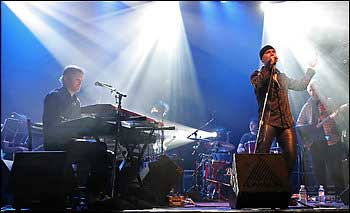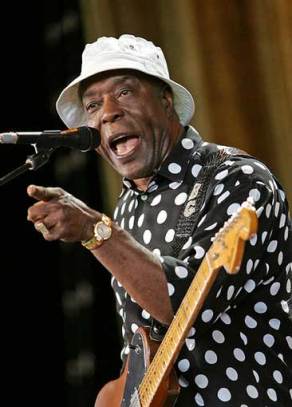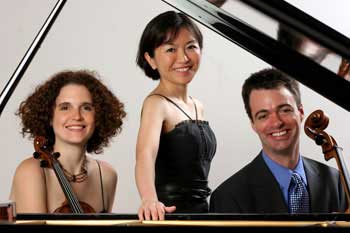East Village Opera Company at Lisner
By Stephen Brookes • The Washington Post • March 31, 2008
________________________________________________________________________
Opera purists, unlock your doors -- it's safe to come out. But if you missed the East Village Opera Company's high-octane show at Lisner Auditorium on Saturday, you missed a chance to hear opera in its wildest new incarnation. The New York-based band turns classical arias into headbanging rock anthems, complete with electric violins, screaming guitar solos and a pair of amped-up singers. And amazingly enough, it works.
 The show got of to a desultory start, though, as if the East Villagers had all just rolled out of bed. Keyboardist Peter Kiesewalter, who founded the band with lead singer Tyley Ross, opened with works by Verdi ("Questa o Quella") and Puccini ("Che Gelida Manina"), and soon singer AnnMarie Milazzo joined Ross for the touching "Flower Duet" from Delibes' "Lakme." And though it was all pleasant enough (Ross and Milazzo both have engaging pop voices, sexed up with a lot of growling and breathiness), they didn't exactly pull out all the stops. Even the fog machine seemed to be bored.
The show got of to a desultory start, though, as if the East Villagers had all just rolled out of bed. Keyboardist Peter Kiesewalter, who founded the band with lead singer Tyley Ross, opened with works by Verdi ("Questa o Quella") and Puccini ("Che Gelida Manina"), and soon singer AnnMarie Milazzo joined Ross for the touching "Flower Duet" from Delibes' "Lakme." And though it was all pleasant enough (Ross and Milazzo both have engaging pop voices, sexed up with a lot of growling and breathiness), they didn't exactly pull out all the stops. Even the fog machine seemed to be bored.
But midway through the show, things suddenly caught fire. Guitarist Ben Butler woke up and began turning in solos that started out searing and got more intense when Pauline Kim joined him on her electric violin. Ross, who'd been floating vaguely around the stage, began to swagger in true rock style, turning in a ferocious account of the Queen of the Night aria from Mozart's "The Magic Flute." The fog machine began cranking out huge clouds of the stuff (and really, what is rock without fog?) and pretty soon, the whole house was clapping along to Handel's 1743 hit "Where'er You Walk." Not something you see every day.
Did the arias take a beating? Well, sure. You're not going to hear the nuance and delicacy that you hear in a traditional operatic performance. But that didn't matter; by show's end, the crowd was on its feet. With its over-the-top emotions and soaring melodies, opera, it turns out, translates beautifully into rock.
Buddy Guy at the Birchmere
By Stephen Brookes • The Washington Post • March 28, 2008
_______________________________________________________________________

By Barry BrecheisenIt would be tough – maybe even impossible -- to find a more influential blues guitarist than Buddy Guy. Smart, fast and spectacularly innovative, he was one of the first to bridge the gap between blues and rock, inspiring everyone from Eric Clapton to Jimi Hendrix to Stevie Ray Vaughan. He never achieved the fame of the superstars who learned from him, earning instead that bittersweet title of "musician's musician." But as he showed in a sold-out, freewheeling powerhouse of a show at the Birchmere on Wednesday, Guy may still -- at 71 -- be the most interesting blues player on the planet.
And one of the most entertaining, too. Backed by his four-piece band, Guy roamed the stage throughout the set, doing songs from his most recent disc ("I've Got Dreams to Remember," "Somebody's Sleeping in My Bed") and channeling blues greats from Willie Dixon ("I Just Want to Make Love to You") to Junior Wells ("Little by Little"). There was a little Hendrix, a little Albert King, even a gentle sendup of Clapton doing "Strange Brew."
And it was all riveting. Guy's playing is virtuosic and amazingly alive, shifting from delicate whispers to brain-searing ferocity with barely time to blink. The whole set was so fluid it felt like a free-flowing stream of consciousness; he'd impulsively stop the band to tell a story, take a little nourishment from a coffee mug at the back of the stage, or pass lines back and forth with pianist Marty Sammon.
"We don't rehearse this stuff," he told the crowd. "If we did, we'd just [mess] it up."
Guy's showmanship was just as engaging as his playing -- the high point of the evening may have come when he descended into the packed crowd, getting women in the audience to pluck his wireless guitar for him. He urged one to sing the line "I'm going to rock you all night long."
"I can't!" wailed the embarrassed victim. "That's all right," deadpanned Guy, after a deftly timed pause. "I can't either."
Rock Opera. Seriously.
By Stephen Brookes • The Washington Post • March 28, 2008
_________________________________________________________________________________
Opera performed on electric guitars? Sounds like a seriously bad idea, says Peter Kiesewalter, founder of the East Village Opera Company.
"If someone were to say to me, 'Check these guys out. They do opera with a rock band,' I don't think I would go," he says, laughing. "I don't think I have an open enough mind."

Kiesewalter (l), Ross, and the bandIt's a pretty interesting remark, coming from someone who has been turning the music world on its ear by transforming the arias of Verdi and Puccini into hard-driving rock anthems. But even though the very idea is enough to give most rockers (not to mention the average opera fan) an aneurysm, the East Village Opera Company's wild, amped-up covers of such 19th-century hits as "La Donna e Mobile" and "Habanera" have been met with surprising enthusiasm by headbangers and opera connoisseurs alike.
"We're just playing this music the way the composers would write it if they were alive today," says Kiesewalter, whose 11-piece band (which includes two singers and a string quartet) will perform music by Mozart, Wagner and others composers Saturday at Lisner Auditorium.
Opera really doesn't need to be handled with kid gloves, he says. It was the pop music of its day and dealt with the same issues (sex, love, sex and more sex) that rock-and-roll does. Drag it out of the culture bunker and into the nightclub, he says, and opera loses none of its vitality; in fact, it seems very much at home.
"Rock and opera go very well together: They're both overblown, massive spectacles," Kiesewalter says. "The sheer size of opera lends itself well to what I call the 'majesty' of rock. And those composers were the rock stars of their time. There was a lot of mystique about them, and their premieres were anticipated as much as a Beatles record. I don't think it's too much of a stretch to compare a composer like Mozart with someone like Prince."
The East Village Opera Company, of course, isn't the first group to drag opera into the modern world. It's almost a cliche to mount the classics in contemporary settings -- a trend pioneered by the director Peter Sellars, who once staged Handel's "Orlando" partly on Mars. Carmen has been reincarnated as a guerrilla fighter, Rigoletto as a New York bartender and, most recently, director Baz Luhrmann brought Puccini's "La Boheme" to Broadway, updated to the 1950s and brimming with references to beatniks and Marlon Brando.
But the problem with those updates, Kiesewalter says, is that everyone's afraid to touch the music itself. "They go to great lengths to try to make it relevant, and yet the most important aspect is the music," he says. "There will be a party scene in 'La Traviata,' and it's set in the 21st century, but people are partying to a waltz, played by a string section! And every effort that they've made to modernize it falls completely on its face."
That's too bad, Kiesewalter says, because opera flourishes when played on modern electric instruments. But injecting Bizet, Handel and Purcell with everything from hip-hop to disco beats takes a deft touch.
"You have to maintain a balance between tradition and renewal, with equal amounts of respect," he says. "Rock is as sophisticated as even the most refined classical music, and it takes someone who has experience playing it to realize how important it is to get it right."
Despite a solid background in rock and classical music (he has a degree in clarinet and composition from Ottawa University), Kiesewalter came late to opera, which he says always left him cold. But in 2001, while working as a house composer for ABC television in New York, he was asked to write the soundtrack to the film "Kiss of Debt," about an aspiring opera singer who works for a mob boss. Because the actor who played the role, Tyley Ross, wasn't classically trained, Kiesewalter set the arias as rock songs.
The music turned out so well that he and Ross eventually recorded a full album of arias, putting a band together in 2004 and debuting at Joe's Pub in New York. "The response was overwhelming," he says, "and it caught us completely by surprise. There were punk rockers in ripped jeans and older people who revere opera. I thought opera purists would throw stuff at us, but they got a bigger kick out of it than anybody. There were subscribers to the Met there, singing along. They knew every word to every aria."
Expect hard-rocking wildness Saturday, when the band will rethink such songs as a love duet in Puccini's "Madame Butterfly" and the virtuosic Queen of the Night aria from Mozart's "The Magic Flute." Don't know opera? Don't worry, Kiesewalter says.
"It's great when the opera cognoscenti come to see us," he says. "But there's something in this music that anyone can respond to. Maybe it's simple: People are suckers for a great melody."
East Village Opera Company Appearing Saturday at Lisner Auditorium, 21st and H streets NW. Show starts at 8.
The Amelia Trio: East Meets West
By Stephen Brookes • The Washington Post • March 17, 2008
________________________________________________________________________
The musical boundaries between East and West have been bashed away at for so long it’s sometimes hard to tell where they are, anymore. From the orientalisme of early 20th Century France to the postmodern work of composers like Tan Dun and Zhou Long, the border has long been a breeding ground for new ideas, and on Saturday evening, the gifted young Amelia Piano Trio (as part of the Dumbarton Concerts series in Georgetown) presented a program called “East Meets West” that explored this music with a playful sense of adventure. Long thought to be lost, Debussy’s early Piano Trio in G Major was recently reconstructed from fragments, and has emerged as an engaging if frustrating work: while full of his characteristic sensuality and passion, it lacks the subtle, translucent lightness of his mature work. Beautifully played by the Amelia, it showed traces of Asia here and there, but never really approached the near-perfect orientalism of later works like "Pagodes."
Long thought to be lost, Debussy’s early Piano Trio in G Major was recently reconstructed from fragments, and has emerged as an engaging if frustrating work: while full of his characteristic sensuality and passion, it lacks the subtle, translucent lightness of his mature work. Beautifully played by the Amelia, it showed traces of Asia here and there, but never really approached the near-perfect orientalism of later works like "Pagodes."
The next work was more of a stretch. Mozart was all of eight years old when he wrote his Sonata in F major, K. 7, and it won’t ever rank as one of mankind’s most glorious achievements -- even when arranged for violin, cello and the two-stringed Chinese violin called the erhu. Wang Guowei turned in a flavorful account of this odd little curiosity, and for what-the-hell programming it was pleasant enough (especially since it was over before you could say “Wolfgang – drink your milk and go to bed”).
But a more organic blending took place in the world premiere of “Scenes Through a Window” by the Chinese-American composer Lu Pei. Written for piano trio, erhu and the traditional lute called the pipa, it’s an extremely smart, colorful and kinetic work that builds on traditional Chinese music without ever descending into sentimentality; utterly graceful playing on the pipa by Yihan Chen made it even more delectable.
The evening closed with a sweeping reading of Maurice Ravel’s Piano Trio in A minor, an early trans-cultural masterpiece which draws on a popular Basque folk dance, Malaysian verse forms, and styles from the Baroque. The Amelia brought it off with exceptional clarity and elegance – a memorable performance of a work much too rarely heard.
Daniel Bernard Roumain, postmodernist
By Stephen Brookes • The Washington Post • March 15, 2008
________________________________________________________________________________

Leslie LyonsDreadlocks flailing, bow clenched between his teeth, nose ring glinting as he storms though a violin solo that that careens from Paganini to Prince -- Daniel Bernard Roumain defies easy pigeonholing. The young Haitian-American composer-slash-performer is aggressively post-modernist, filtering jazz, hip hop, electronica and a dozen other genres through his own classical mind-set -- and writing music that explores equally post-modern questions of identity.
Roumain – or “DBR” as he’s professionally known – is a rising star of the new music scene, writing for major orchestras and performing regularly with his own nine-piece band, “DBR and the Mission.” But he showed off a more intimate side in two concerts here this week, performing works for electric violin and electronics at The Mansion at Strathmore on Monday, and an 80-minute multimedia work titled “One Loss Plus” on Thursday night at the Clarice Smith Center.
Of the two, Monday night’s concert was the most personal, and perhaps the most revealing. The Shapiro music room at The Mansion is a tight space, and its dark wood paneling, gilded chandeliers and enormous marble fireplace seem better suited for string quartets than the turntables, Powerbooks and six-string electric violin that Roumain uses. But he was clearly in his element, talking at length to the overflow crowd and performing a range of very personal works, from the intriguing “Sonata for Violin and Turntables,” to music from his most recent disc, “etudes4violin&electronix.”
And despite all the cutting-edge trappings, the music was involving, tonal and eminently accessible, steeped in the wash-rinse-repeat cycle of minimalism but sexed up considerably with hip hop rhythms, jazz riffs and imaginative collaboration from laptopist and turntablist Elan Vytal (aka DJ Scientific).
Much of it had a deeply contemplative feel, and though that’s usually just a polite term for thumb-twiddling, Roumain proved how adept he is at building lyrical, slowly-changing structures that evolve with deep organic unity, building to wailing peaks any rock guitarist would be proud of.
 That said, the music could often be frustrating, too. Roumain confines himself to a fairly narrow harmonic and rhythmic palette, and though he writes engaging melodic motifs, he doesn’t develop them very far or take them into daring territory; it’s music designed to please, rather than challenge. And while he borrowed extensively on Monday from the edgy world of hip hop, much of the music seemed just that -- borrowed, with its teeth filed down and its attitude tamed.
That said, the music could often be frustrating, too. Roumain confines himself to a fairly narrow harmonic and rhythmic palette, and though he writes engaging melodic motifs, he doesn’t develop them very far or take them into daring territory; it’s music designed to please, rather than challenge. And while he borrowed extensively on Monday from the edgy world of hip hop, much of the music seemed just that -- borrowed, with its teeth filed down and its attitude tamed.
The sprawling, of-the-moment multimedia piece “One Loss Plus” that Roumain performed three days later was a much more complex affair, adding video, prepared piano (played by Wynne Bennett) and the singer Emeline Michel to the composer’s electric violin. It’s about “what is gained when something is lost, and mourning, and how we mourn,” Roumain said in an interview before the concert. “And I think of it as a piece for violin and piano exploded – it’s grappling with multiple traditions from multiple points of view.”
It’s an ambitious idea with rich potential, and for the most part Roumain brought it off well. Stalking the stage while videos of people discussing loss (culled largely from YouTube) played on two huge screens, he created a sweeping, emotionally charged score that ranged from dreamlike to furious to darkly elegiac.
But there was little narrative tension to the overall work, and the performance, after quickly making its point, seemed unsure where to go. People appeared on screen reciting the alphabet, the performers played from a numeric score projected overhead, and eventually you felt as if you’d been swept underwater, floating in a pleasant if aimless sea of sound. But as the piece closed, Emeline Michel joined Roumain on stage for a prayerful coda, sung in Creole; the effect was magical, and redeemed the evening.
Terry Riley's "The Cusp of Magic"
By Stephen Brookes • The Washington Post • March 9, 2008
__________________________________________________________________________
 You don't need to eat peyote buttons to appreciate "The Cusp of Magic" -- though it probably wouldn't hurt. The opening and closing movements of this fascinating work by California composer Terry Riley are based on Native American peyote rituals, and the music in between -- at turns luminous, frightening and unbearably lovely -- shimmers with the elusive delicacy of a dream. Performed by the Kronos Quartet (which commissioned the work), "Cusp" takes its title from the summer solstice, and evokes those transitional moments in life when the sharp edges of reality become blurred, and anything seems possible.
You don't need to eat peyote buttons to appreciate "The Cusp of Magic" -- though it probably wouldn't hurt. The opening and closing movements of this fascinating work by California composer Terry Riley are based on Native American peyote rituals, and the music in between -- at turns luminous, frightening and unbearably lovely -- shimmers with the elusive delicacy of a dream. Performed by the Kronos Quartet (which commissioned the work), "Cusp" takes its title from the summer solstice, and evokes those transitional moments in life when the sharp edges of reality become blurred, and anything seems possible.
Riley has grown in recent years from a minimalist to a little-of-everything-ist, and in "Cusp" he incorporates singing, a synthesizer, children's toys, a drum and the traditional Chinese "pipa" lute (played here by Wu Man) to bend and blend musical genres with protean ease. The effect is, in a word, magical: You have the sense of being swept into a surging ocean of memory, where lullabies float up over mysterious drones, nervous waltzes twist suddenly into quirky little marches, and nothing is ever quite what it seems. But the music never descends into runaway eclecticism: Riley's touch remains both sure and deft throughout, and the effect is powerful.
Chavez, Revueltas to Square Off in DC
By Stephen Brookes • The Washington Post • March 7, 2008
________________________________________________________________________________

Carlos ChavezA small but furious musical brawl is shaping up here next week, when partisans of Mexico's most eminent composer, Carlos Chávez, will square off against equally zealous supporters of the long-neglected Silvestre Revueltas. There's not much at stake, unless you care who wears the imaginary crown of "Mexico's Greatest Composer" (and really, do you?). But the five-day program of concerts, films and discussions may be a highlight of the musical season, as it turns a revealing spotlight on Revueltas, one of the most wildly original -- and deeply tormented -- musicians of the 20th century.
"Revueltas is a spontaneous composer with an eruptive, vibrant personality, and he's one of the most important composers ever produced in the Western Hemisphere," says Joseph Horowitz, a program organizer and artistic director of the Post-Classical Ensemble, one of the groups performing. "He's been the victim of ignorance and prejudice, but we're much more ready for his music than we were 20 years ago."
That's the proposition behind "Two Faces of Mexican Music: Carlos Chávez (1899-1978) and Silvestre Revueltas (1899-1940) Revisited," which starts Tuesday and features concerts by the prize-winning Cuarteto Latinamericano, the Camerata Interamericana and the Post-Classical Ensemble (with the Mexican singer Eugenia Leon). The National Gallery will also host screenings of the Revueltas-scored films “Redes” (with cinematography by the great Paul Strand) and the irresistibly titled “¡Vámonos con Pancho Villa!” from 1936.
And at the very least, it promises to be a fascinating study in contrasts. Chávez and Revueltas came of age at the close of the Mexican revolution as the country was going through a sort of artistic renaissance. Painters such as Diego Rivera and Frida Kahlo were forging a new nationalistic cultural identity, and composers, too, began exploring what it meant to be Mexican. Foremost among them was Chávez.
Chávez was unmistakably brilliant. He carved out a preeminent role as conductor, teacher and administrator, heading the Mexican Symphony Orchestra and the National Institute of Fine Arts. In his mid-20s he was winning praise from composers including Aaron Copland for works that still define modern Mexican music: sophisticated, rooted in the music of the pre-Columbian past, but with an international outlook closer to Stravinsky and neoclassicism than to anything you'd hear in the streets of Mexico City.

Silvestre RevueltasRevueltas, on the other hand, was a maverick -- and something of a train wreck. Trained as a violinist, he bounced between Mexico and the United States in his early years until Chávez took him under his wing in 1929, appointing him assistant conductor of the National Symphony. But Revueltas never settled into respectability the way Chávez did. Idealistic, charismatic, hard-drinking, and in and out of mental hospitals much of his life, Revueltas lived on the edge and eventualy paid the price, dying at age 40 after a long night of drinking.
It was a life lived at full tilt, and his music shows it. Revueltas composed brash, explosive masterpieces in his 30s that are original, thoroughly Mexican and seething with a kind of intensity Chávez never matched. Inspired by the "mestizo" (mixed) culture of the villages and committed to the cause of the oppressed (he traveled to Spain to support the anti-Franco forces during the country's civil war), Revueltas took the rough, vital rhythms of rural Mexico and transformed them into works of extraordinary vividness and power. That, his supporters say, makes such masterpieces as "Sensemaya" and "Ventanas" far more "authentic" than the stylish international modernism of Chávez.
"Both are great composers, but Revueltas is more authentically Mexican, because he was more tied into local traditions," says associate history professor James Krippner of Pennsylvania's Haverford University, who will be making the case for Revueltas during one of next week's panel discussions.
For all its extraordinary vitality, though, Revueltas's music was widely dismissed after his death, and he fell into obscurity while Chávez (who lived and worked into his late 70s) saw his reputation steadily rise. But in the past decade, a growing number of musicians, particularly the Los Angeles Philharmonic and its former conductor, Esa-Pekka Salonen, have begun to champion Revueltas. Some think he'll soon eclipse Chávez on the world stage.
For the Post-Classical Ensemble's Horowitz, at least, there's little doubt. "There are always composers who fall through the cracks," he says. "But Revueltas is a composer whose time has come."

